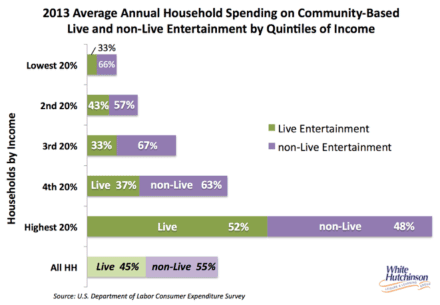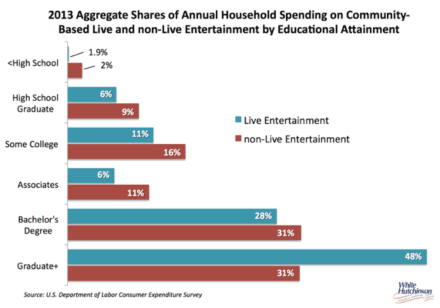
Vol. XV, No. 2, February-March 2015
- Editor's travelogue & more
- Vietnam's largest FEC opens
- How much Americans love pizza
- Real live escape game venues continue to multiply
- Under-the-radar bar trend
- Announcing Foundations Entertainment University 2.0
- How to boost your posts on Facebook
- National survey results for participation in FEC activities
- The power of live events
- Free scholarships to Birthday University, April 2
- The full scoop on market & financial feasibility studies
- Nationwide laser tag participation survey results to be revealed at Laser Tag Convention
- The rise of super Digital Hiving
- The no vacation trend continues
- IRS changes rules on automatic group tips
The power of live events
We've written a lot in issues of this Leisure eNewsletter about spending and participation trends with out-of-home community entertainment. However, we've never delved into analysis of live versus non-live entertainment. By live entertainment we are referring to attendance at a music performance or concert, some type of theater performance or attending a sports event. Non-live includes movie theaters, museums, zoos, and most activities at family entertainment centers where the entertainment is interacting with some sort of equipment such as driving go-karts, playing a game, shooting a laser gun or rolling a bowling ball.
When we look at 2013 household spending at community entertainment venues (within 50 miles of home and not on an overnight trip) excluding attendance at sports events, we find a distinct pattern. The higher socioeconomic households, whether you measure it by income or by education, are not only the bigger spenders on non-live entertainment, but they are also bigger spenders on live entertainment. All but the top 20% of income households spend much less on live entertainment than non-live entertainment. The top 20% of income households spend more on live entertainment than non-live and account for far more live entertainment spending than the other 80% of households combined. The top quintile of income households account for 61% of all live event spending.

The same pattern is true when we look a community entertainment household spending based on the highest educational attainment of a member of the household. Households with a graduate degree spend more on live than on non-live community entertainment and although they make up only one-sixth (16%) of all households, they account for almost one-half (48%) of all live community entertainment spending. Households with a Bachelor's degree or higher degree represent 3/4s (76%) of all live entertainment spending at their community venues.

When we look at admissions to sporting events in the local community, we find the exact same pattern. The highest 20% of income households account for more spending than the other 80% of lower income households combined. The top 20% account for 60% of all such spending.
Obviously, the high cost of most live entertainment and sport events accounts for a lot of this pattern of high spending by the highest socioeconomic households - the lower socioeconomic households just can't afford it, or at least not that often. Conversely, the power of in-person live events, their High Fidelity, accounts for garnering the majority of the highest socioeconomic households community entertainment spending. In-person live events are uniquely powerful experiences. There is the power of being together in a theater, a club or stadium full of other people sharing the same experience as you. And smartphones allow photos and videos to be uploaded to social media to share with your friends who aren't there and to acquire social cachet. The limited time availability of live events also greatly enhances their appeal.
Why is it important to understand this pattern? It's because the top 40% of income households, basically the upper-middle and higher income households, account for three-quarters of all community-based entertainment spending. They are the market to target. And of their spending, almost one-half is devoted to live events. They have the discretionary incomes to afford live events, and obviously the High Fidelity of in-person attendance at live events has high appeal to them.
Like the overall trend of decreasing participation and spending at location-based entertainment venues we have been reporting on in this eNewsletter, there is also a trend of a decreasing percentage of the population attending live events, and of those that do, a decrease in the number of events they attend each year for sporting events and music concepts. The one exception for this is for family live events where participation has held steady for the past four years and there has been an increase in the number of times attending each year.

So what this all indicates is that there is more to community entertainment success than just entertainment equipment. Live entertainment can be a very important component and offers the opportunity to differentiate a center from an equipment-only one. Changing live entertainment also adds to a venue's repeat appeal.
Vol. XV, No. 2, February-March 2015
- Editor's travelogue & more
- Vietnam's largest FEC opens
- How much Americans love pizza
- Real live escape game venues continue to multiply
- Under-the-radar bar trend
- Announcing Foundations Entertainment University 2.0
- How to boost your posts on Facebook
- National survey results for participation in FEC activities
- The power of live events
- Free scholarships to Birthday University, April 2
- The full scoop on market & financial feasibility studies
- Nationwide laser tag participation survey results to be revealed at Laser Tag Convention
- The rise of super Digital Hiving
- The no vacation trend continues
- IRS changes rules on automatic group tips


